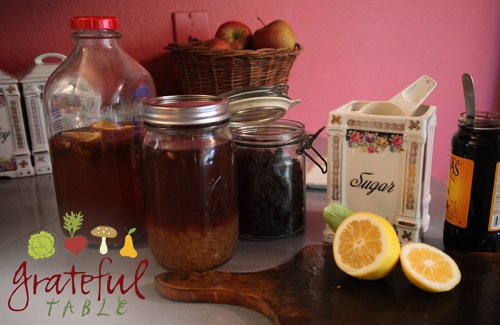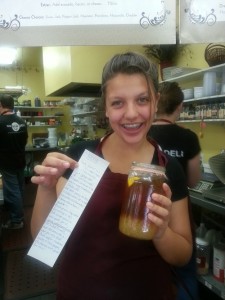My sister-in-law’s on the cutting edge. She’s the one who told me about Water Kefir. I was kind of surprised that I didn’t even know that kefir has way (way) more probiotics than bottled supplements, or yogurt.
 Michelle (daughter-in-law) gave me a few milk “grains” to culture my own milk kefir. I’m not much of a milk drinker, and I don’t like how commercial milk is treated. But, I didn’t want to spend the extra money to get fancy, organic milk either. Besides, it still wouldn’t be raw, and I can be such a purist sometimes. Plus, my husband is still not letting me get a little goat, much less a cow, so… my heart just wasn’t in the whole milk-kefir-brew thing.
Michelle (daughter-in-law) gave me a few milk “grains” to culture my own milk kefir. I’m not much of a milk drinker, and I don’t like how commercial milk is treated. But, I didn’t want to spend the extra money to get fancy, organic milk either. Besides, it still wouldn’t be raw, and I can be such a purist sometimes. Plus, my husband is still not letting me get a little goat, much less a cow, so… my heart just wasn’t in the whole milk-kefir-brew thing.
 Then I started hearing about water kefir. (For my full recipe on how to make that, go here: Full Water Kefir Recipe.) Thank you, sis-in-law, for mentioning this to me! She’s one of my more health-conscious relatives, who introduced me to “Diet for a Small Planet” back in the 70’s. She had heard you could culture kefir with coconut water.
Then I started hearing about water kefir. (For my full recipe on how to make that, go here: Full Water Kefir Recipe.) Thank you, sis-in-law, for mentioning this to me! She’s one of my more health-conscious relatives, who introduced me to “Diet for a Small Planet” back in the 70’s. She had heard you could culture kefir with coconut water.
Well, what was stopping us?! I didn’t want to just talk about it. Why didn’t we already have some brewing?! What was slowing us down?! With Amazon at my fingertips, it was easy to order a small package of water kefir grains. It came with a nice little instruction sheet that answered most of my questions. Yay. (I took notes, as you can see on the scrap paper I gave to my friend Vanessa.)
Local friends and family don’t need to order their own grains, since the grains multiply. I’ve been able to get the girls at work started on this stuff, and some other folks too. Again, if you want the detailed directions, check out my simplified, easy water kefir recipe here.
But what’s all the excitement about? Kefir cleans the digestive tract, so no toxic contents in food go into your bloodstream. It’s enzyme-rich, full of electrolytes, amino acids and active live cultures, it’s loaded with vitamin B-12, vitamin K and biotin. And, it’s bubbly and rather delicious!
When you start drinking kefir regularly, you’ll probably notice that your digestion and metabolism improve. It might even help those battling leaky gut syndrome and colon cancer, yeast infections and general immune system issues. And, it helps regulate cholesterol and blood sugar levels. SIGN ME UP, right?
 But… where do water kefir grains come from? Wikipedia says they have been found on a type of Mexican cactus; granules of the water kefir could be scraped off and cultured in sugar water. Other stories suggest that the grain was a gift from God. Maybe it’s both!
But… where do water kefir grains come from? Wikipedia says they have been found on a type of Mexican cactus; granules of the water kefir could be scraped off and cultured in sugar water. Other stories suggest that the grain was a gift from God. Maybe it’s both!

So can I take this mix and add champagne yeast to it and make alcohol and still have the probiotics?
Well, if we’re getting serious about the “wine” part, lol… it looks like yes, you could add the champagne yeast and still have probiotics in it. I had to dig some, but I found info on the website for “Boochcraft” (www.boochcraft.com/faq/). They say, “The primary beneficial probiotic Lactobacillus, can happily live in alcohol well beyond 8%”. They’re letting folks know about their product, but it’s helpful for us home-brewers too. They say that they “allow the alcohol level to rise a few percent before adding fresh pressed juice and herbs to flavor it.” Apparently, they use kombucha as a base, and add the champagne yeast to it to bring up the alcohol level, then add the juices for flavoring. So- sounds like you could totally do this! The best of both worlds! 😀
Hi, Your recipe does not state that you strain the mix, is this omitted or not, I would have thought that using non chlorinated water all round, as in making the mixture to rinsing the grains, plus why the two sugars, would be rather too sweet for some, also is it all done with cold, warm, hot or boiling water, do you use plastics and wooden utensils or metal utensils
So many great questions Karen. I have the full recipe here: gratefultable.com/easy-simple-directions-water-kefir-natural-soda. But to answer your questions here too, yes, I do try to use plastic for straining the greens and for the funnel. I haven’t noticed metal being a problem if it’s only used momentarily (like when dipping a spoon into it briefly).
I also don’t worry about using non-chlorinated water when I’m rinsing the grains. Rinsing in tapwater has not seemed to have a negative affect. But I do allow a few minutes for the tap water to drain off, and shake the strainer a bit.
I like using white sugar and molasses, since I tend to add a little more molasses to the mix than brown sugar would have in it. This gives the grains a few extra minerals to thrive on. But brown sugar substitutes just fine.
Room temperature water works great. Someone posted a video where they dissolved the sugar in warm water first, and then it had to be cooled off. But if you just add the sugar, molasses, and the room-temperature, filtered water to the jar and shake it up really well, the sugar dissolves just fine and you don’t have to wait for the stuff to cool!
Hope your Kefir-brewing goes well. It’s pretty forgiving, although it would not like to be rinsed with hot water!